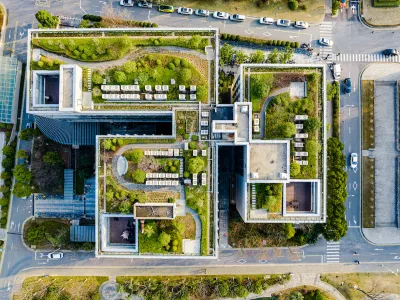The cheapest energy is energy not used.

A white paper released by the World Economic Forum and PwC outlines “actionable interventions” that could reduce emissions from buildings by up to 38 percent. As Nish Amarnath explains in Smart Cities Dive, these interventions include efficiency measures and electrification.
“Demand-side actions can be undertaken by “‘reallocating previously wasted or unnecessarily used energy to new consumers and/or new uses,’ the paper says, noting that the cheapest form of energy is ‘energy that is not used.’” In addition to reducing the amount and intensity of energy used, the paper recommends “retrofits and other upgrades that enable buildings to use less energy to perform the same task and are typically funded by capital expenditure with payback in less than 15 years.”
The paper adds a more systemic solution. “As a third lever, it recommends collaboration measures across the value chain, such as changing building design, putting in place district heating and cooling systems and district energy management systems, on-site energy production and storage, and the use of greener materials as well as demand response programs.”
FULL STORY: Buildings can reduce energy intensity by up to 38%: report

National Parks Layoffs Will Cause Communities to Lose Billions
Thousands of essential park workers were laid off this week, just before the busy spring break season.

Retro-silient?: America’s First “Eco-burb,” The Woodlands Turns 50
A master-planned community north of Houston offers lessons on green infrastructure and resilient design, but falls short of its founder’s lofty affordability and walkability goals.

Delivering for America Plan Will Downgrade Mail Service in at Least 49.5 Percent of Zip Codes
Republican and Democrat lawmakers criticize the plan for its disproportionate negative impact on rural communities.

Test News Post 1
This is a summary

Test News Headline 46
Test for the image on the front page.

Balancing Bombs and Butterflies: How the National Guard Protects a Rare Species
The National Guard at Fort Indiantown Gap uses GIS technology and land management strategies to balance military training with conservation efforts, ensuring the survival of the rare eastern regal fritillary butterfly.
Urban Design for Planners 1: Software Tools
This six-course series explores essential urban design concepts using open source software and equips planners with the tools they need to participate fully in the urban design process.
Planning for Universal Design
Learn the tools for implementing Universal Design in planning regulations.
EMC Planning Group, Inc.
Planetizen
Planetizen
Mpact (formerly Rail~Volution)
Great Falls Development Authority, Inc.
HUDs Office of Policy Development and Research
NYU Wagner Graduate School of Public Service





























